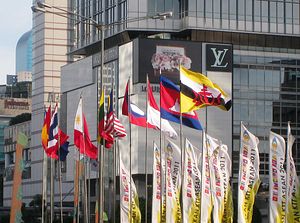ASEAN economic ministers have reportedly broadly agreed to sharply reduce barriers on almost all of their product lines in a bid to make the Regional Comprehensive Economic Partnership (RCEP) trade agreement a reality. Though this might represent an incremental step forward in dramatically lifting trade within an area boasting almost 40 percent of global GDP, familiar challenges still remain.
According to the Philippine Trade Secretary, Ramon Lopez, Southeast Asian ministers have agreed on a few key points as they look to make progress on RCEP, which has gained even more traction following the U.S. withdrawal from the Trans-Pacific Partnership (TPP).
Lopez said nations that sign up for the free trade agreement should commit to remove barriers on at least 92 per cent of their product lines over five to ten years. He said all ten ASEAN members have signed up to this, and anything less would be unacceptable.
However, India is unsurprisingly still resisting pressure to meet liberalizing targets, which could stymie what some are calling a mega-regional economic agreement.
“India managed to convey that it was not ready to commit to tariff elimination on the whole gamut of items that other members are pushing for as it needed to cover the sensitivities of its industry and agriculture,” a government official told BusinessLine.
“The pressure on the Indian Minister this time surprisingly was lower than usual and it was dealt with well. But Trade Ministers are determined to get the negotiations moving at the next meet in November in Manila,” the official said.
Differences elsewhere still exist, which has forced negotiating countries to abandon an initial end of year deadline to reach an agreement on the trade pact in yet another in a series of recurring delays.
RCEP is a proposed free trade agreement between the 10 members of ASEAN and the six states with which the trading bloc already has free trade agreements; Australia, China, India, Japan, New Zealand and South Korea.
“Hopefully, their (final) submissions will be within the parameters we’ve set,” Lopez told reporters after the economic ministers agreed on baseline targets for further talks at the meeting in Manila.
The RCEP was officially launched at the 2012 ASEAN summit in Cambodia, and as a potential trade deal rose in prominence after U.S. President Donald Trump scrapped his country’s backing for the Trans-Pacific Partnership (TPP) following his election.
The remaining 11 TPP signatories – the so-called “TPP-11” are still to decide whether to go it alone without the United States or abandon the deal all together.
RCEP will boast a population of 3.4 billion people – more than half coming from India and China – with a total gross domestic product of $49.5 trillion or about 39 percent of the world’s GDP.
Although the RCEP is not expected to be approved this year, Lopez said he was confident the 16 nations involved would at least agree on market access, a schedule and rules that can be signed-off on when leaders meet in the Philippines for their next summit in November.
“The takeaway now is that there is convergence among ASEAN, plus a few dialogue partners. When you see most have converged, there’s pressure on the holdouts. Hopefully, this will accelerate the negotiations,” he said told reporters.
Luke Hunt can be followed on Twitter @lukeanthonyhunt

































